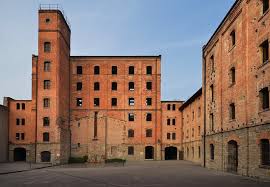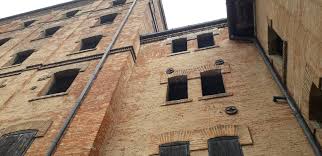


The Risiera di San Sabba was built in Trieste in the district of San Sabba (now Valmaura) back in 1913. Initially it was a rice husking plant. But it was soon transformed by the Nazis into a provisional prison camp for Italian soldiers captured after 8 September 1943.
In the following months the camp was transformed into a police detention camp ("Polizeihaftlager") to which prisoners were transferred to be sorted into German and Polish concentration camps.

Many people including: hostages, political prisoners (Italians, Slovenes, Croats), Jews and partisans found death in this camp. After a few days of grueling waiting, in fact, their predetermined end was to be killed or cremated without the citizens being able to notice anything.
Some estimates confirm that between three and five thousand people died in this field. But the number gets significantly higher, considering. even those prisoners or persecuted who passed through here to be then sorted to other European concentration camps (Dachau, Buchenwald and Mauthausen for politicians, Auschwitz and then Bergen Belsen for the Jews) or to compulsory work.
In 1965 the Risiera di San Sabba was declared a National Monument by decree of the President of the Republic. And, currently, this monument represents the only concentration camp equipped with a regulated crematorium on the Italian territory.

Between 1966 and 1975, the Risiera underwent a massive renovation directed by the architect Romano Boico who tried to save what little was left of it.
Thus, the architect wanted to explain the rationale on which his renovation work was based:
"The rice mill half destroyed by the fleeing Nazis was squalid like the peripheral surroundings: I then thought that this total squalor could become a symbol and monumentalize itself. I set out to remove and return, rather than add.
Once the ruined buildings were eliminated, I surrounded the context with eleven-meter high concrete walls, articulated in such a way as to configure a disturbing entrance in the same place as the existing entrance. The enclosed courtyard identifies itself, in intention, as a lay basilica with an open sky.
The prisoners' building is completely emptied and the wooden load-bearing structures stripped of what seemed necessary. Unaltered the seventeen cells and those of death. In the central building, at the level of the courtyard, the Museum of the Resistance, concise but alive. Above the Museum, the compartments for the deportees' Association. In the courtyard a terrible steel path, slightly recessed: the imprint of the oven, the smoke channel and the base of the fireplace ".

Once the restoration work was completed, in 1975, the Civic Museum of the Risiera di San Sabba was inaugurated. Inside it is still possible to visit an itinerary of the historical exhibition, created between 1982 and 1998, by Elio Apih.
This itinerary retraces, through reproductions of documents and testimonies, the history of the Risiera also touching upon the historical, political and military events that affected this strip of Italy in the first half of the twentieth century.
From January 27, 2002, "Day of Remembrance", the Museum has become, thanks to some important bequests, also a place for the conservation of Memory where the "tangible and direct evidence of human suffering and tragedy" are still kept.

The current Risiera is very different from that of then. After all, the Nazis, leaving the city half destroyed it so as not to leave a trace.
Outside, the courtyard remains. From here you can access the central building where the Museum of the Resistance was built. Upstairs, on the other hand, the Offices for the Deported Association have been created.
Inside, however, the Hall of Crosses can still be visited, in which those arrested for racial and political reasons were waiting to be deported to other European concentration camps, the prisoners' building with microcells, the imprint of the crematorium, the Museum and the Hall of Commemoration, which houses the statue dedicated to the martyrs of Auschwitz created by the Trieste sculptor Marcello Mascherini.

How to reach the Risiera di San Sabba
The Risiera di San Sabba is about five kilometers from the center of Trieste and is easily accessible by car or by bus.
By car, along the great Trieste road network (GVT), follow the signs for Valmaura - Nereo Rocco Stadium. By bus, instead, take lines 8 or 10.
Entrance to the Risiera is free.
The Risiera di San Sabba
Address: Via Giovanni Palatucci, 5, 34148
Phone: +39 040 826 202
Site:
https://risierasansabba.it/Location inserted by
Marco Cadelli